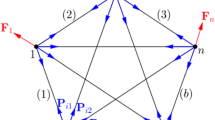Abstract
For mechanical structural design, topology optimization is often utilized. During this process, a topologically optimized model must be converted into a parametric CAD solid model. The key point of conversion is that a discretized shape of a topologically optimized model must be smoothed, but features such as creases and corners must be retained. Thus, a surface reconstruction algorithm to produce the parametric CAD solid model from a topologically optimized model is proposed in this paper. Our presented algorithm consists of three parts: (1) an enclosed isosurface geometry from which the topologically optimized model is generated, (2) features detected and (3) the parametric CAD solid model reconstructed as biquartic surface splines. In order to generate an enclosed isosurface model effectively, we propose an algorithm based upon the marching cubes method to detect elements intersected by an isosurface. After generating an enclosed isosurface model, we produce biquartic surface splines. By applying our algorithm to an enclosed isosurface model, it is possible to produce smoothed biquartic surface splines with features retained. Some examples are shown and the effectiveness of our algorithm is discussed in this paper.









Similar content being viewed by others
References
Bendosøe MP, Kikuchi N (1988) Generating optimal topologies in structural design using a homogenization method. Comp Methods Applied Mech Eng 71:197–224
Bendosøe MP, Diaz AR and Kikuchi N (1993) Topology and generalized layout optimization of elastic strucres, topology design of structures. Kluwer, Dordrecht, pp 159–206
Sethian JA, Wiegmann A (2000) Structural boundary design via level set and immersed interface methods. J Comput Phys 163:489–528
Allaire G (2004) Topology optimization with the homogenization and the level-set method. P. Ponte Castaneda et al. (eds) Polycrystals and smart materials. Kluwer, Dordrecht, pp 1–13
Diaz AR, Kikuchi N (1992) Solution to shape and topology eigenvalue optimization problem using a homogenization methods. Int J Numer Methods Eng 35:1487–1502
Ou JS, Kikuchi N (1996) Integrated optimal structure and vibration control design. Struct Optim 12(4):209–216
Sigmund O (2001) Design of multiplhysics actuators using topology optimization Part I. Comp Methods Appl Mech Eng 190(49–50):6577–6604
Sigmund O (2001) Design of multiplhysics actuators using topology optimization Part I One-material structures. Comp Methods Appl Mech Eng 190(49–50):6605–6627
Eck M, Hoppe H (1996) Automatic reconstruction of B-spline surfaces of arbitrary topological type. SIGRAPH ’96, 325–334
Park IK, Yun ID, Lee SU (1999) Constructing NURBS surface model from scattered and unorganized range data. In: Proceedings of second international conference on 3D digital imaging and modeling. Ottawa, Canada
Park IK, Lee SU (1997) Geometric modeling from scattered 3D range data. IEEEE Proc Int Conf Image Process 2:712–715
Park IK (2000) Automatic 3D model synthsis from measured range data. IEEE Trans Circuits Systems Video Tech 10(2):293–301
Peters J (1993) C1 surface splines. SIAM J Anal 32(2):645–666
Peters J (1994) Constructing C1 surfaces of arbitrary topology using biquadratic and bicubic splines. In designing fair curves and surfaces. SIAM 277–293
Peters J (1995) C1 surface splines over irregular meshes. Comp Aided Des 27(1):895–903
Chang KH, Tang PS (2001) Integration of design and manufacturing for structural shape optimization. Adv Eng Softw 32(7):555–567
Lorensen WE, Cline HE (1987) Marching cubes: A high resolution 3D surface construction algorithm. Int Conf Comp Graph Interact Tech: 163–169
Shen HW, Johnson CR (1995) Seeping simplifies: A fast isosurface extraction algorithm for unstructured grids. In: Proceedings of Visualization: 143–151
Itoh T, Koyamada K (1995) Automatic isosurface propagation using an extra graph and boundary cell lists. IEEE Trans Visual Comp Graph 1 4:319–327
Itoh T, Yamaguchi Y, Koyamada K (2001) Fast isosurface generation using the volume thinning algorithm. IEEE Trans Visual Comp Graph 7(1):32–46
Tang CK, Medioni G (1999) Robust estimation of curvature information from noisy 3D data for shape description. In: Proceedings of the 7th international conference on computer vision, Kerkyra Greece, pp 426–433
Medioni G, Lee MS, Tang CK (200) A computational framework for segmentation and grouping. Elsevier, Amsterdam
Page DL, Koschan A, Sun Y (2001) Estimation of piecewise smooth surfaces from triangle mesh approximation using normal voting. In: Proceedings of the international conference on computer vision and pattern recognition, Kauai HI 162–167
Sun Y, Page DL, Paik J (2002) Triangle mesh based edge detection and its application to surface segmentation and adaptive surface smoothing. IEEE Int Conf image process, Rochester NY 3:825–828
Acknowledgments
Financial support from Quint Corporation in Japan for this research is highly appreciated. Authors thank Dr. Keizo Ishii who is the president of Quint Corporation.
Author information
Authors and Affiliations
Corresponding author
Rights and permissions
About this article
Cite this article
Koguchi, A., Kikuchi, N. A surface reconstruction algorithm for topology optimization. Engineering with Computers 22, 1–10 (2006). https://doi.org/10.1007/s00366-006-0023-0
Received:
Accepted:
Published:
Issue Date:
DOI: https://doi.org/10.1007/s00366-006-0023-0




